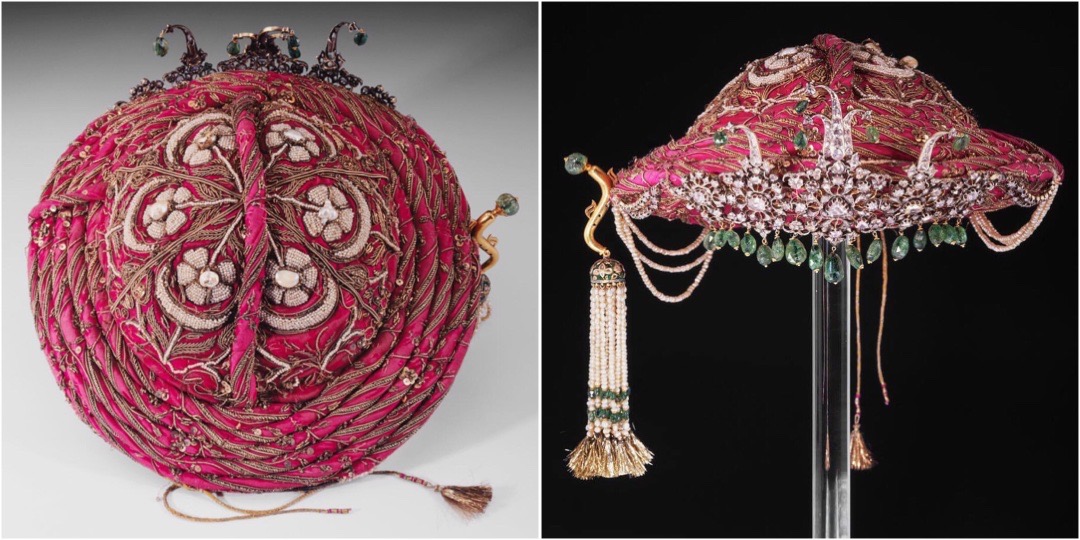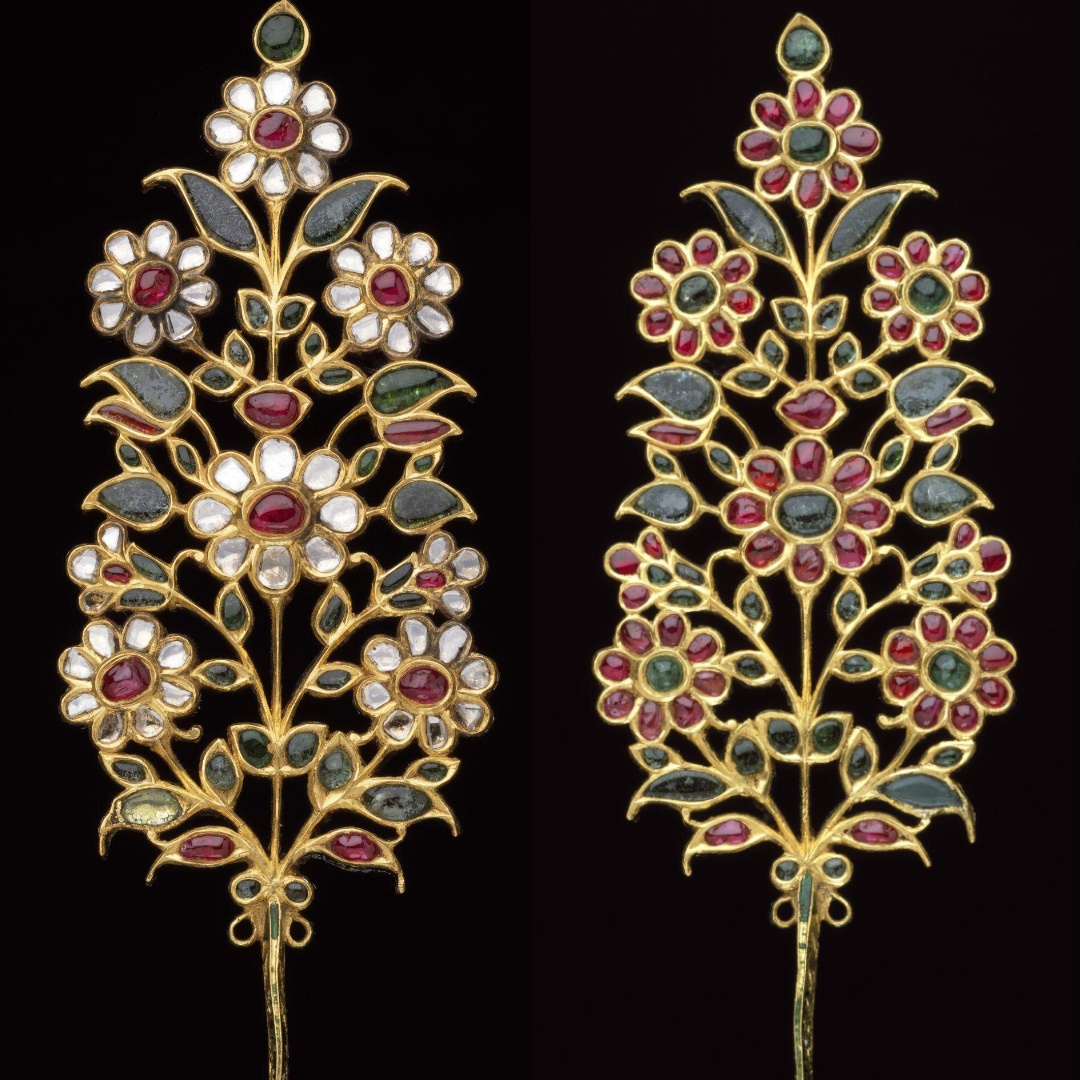Head Ornaments worn by the royal authority reflected their power, righteousness, victory, and triumph and identified an individual’s political hierarchy. The more heavy and bejeweled the head ornament the higher the ranking of the wearer. In my article, I am unboxing a plethora of head ornaments worn by the Indian Maharajas that were adorned with the finest gemstones.
Maharaja of Nawanagar

Featured above is a Belle Époque Diamond Jigha worn by the Maharaja of Nawanagar. The speciality of this all-diamond Jigha is that it was made in 1907 and remodelled around 1935 by Cartier. The ornament is set in white gold with an old baguette and pear-shaped diamonds, and on the reverse is a plume holder. The lower part of the ornament is detachable and can be worn as a brooch.

Next, from the treasury of Maharaja of Nawanagar is a Cushion modified mixed-cut 109.50cts Sri Lankan sapphire turban ornament; set with white diamonds and inlaid in platinum; which can also be worn as a brooch and a magnificent 61.50-carat whiskey-colored diamond mounted with baguette-cut diamonds in platinum by Cartier. The fascinating aspect of this head ornament is that like many other fine jewels, it was designed to be worn in multiple ways, and one of the most interesting part is that the setting can be un-clipped, releasing the diamond completely. Maharaja of Nawanagar enjoyed wearing the ornament with a plume of pure white egret feathers.
Maharaja Of Baroda

The Gaekwads of Baroda ruled the princely state of Baroda in western India from the early 18th century until 1947. Featured above are the different maharajas of Baroda with exclusive head ornaments.
1. H.H. Samarjitsinh Ranjitsinh Gaekwad; crowned Maharaja in a traditional ceremony at Laxmi Vilas Palace on 22 June 2012.
2. Maharaja Malhar Rao Gaekwad (1870 – 1875) is wearing sarpech along with an elaborate Baroda necklace.
3. Maharaja Sayajirao Gaekwad III (1875 –1939) is also wearing a similar style sarpech with pearl tassels.
4. Maharaja Pratap Singh Rao Gaekwad (1939 – 1951) is wearing an emerald aigrette inspired by European design.
Did you like the varied head ornaments worn by the Baroda kings? Let me know in the comment.

One of the most exclusive head ornaments from the treasury of Maharaja Of Baroda is the Baroda Aigrette made by Cartier. The aigrette is made of the foliage of white gold & cushion, oval cut, pear cut & briolette white diamonds.
Did you know: that most of the Indian maharajas; such as Maharajas of Baroda, Kapurthala, Nawanagar, Patiala, Indore, and Jodhpur to name a few; all bought jewellery from Cartier. The story goes that Cartier’s love affair with India began around 1911 when Jacques Cartier travelled from London to attend the Delhi Durbar marking the accession of King George V of England as Emperor of India; he met the Maharaja and showed them cases of jewels and watches from Paris. After the Delhi Durbar, Jacques Cartier was invited to visit many palaces around the country and designed exquisite jewels for the Indian Maharajas.
Chhatrapati of Satara in Maharashtra

From Baroda, I am taking you straight to Maharashtra! Featured above is the Royal Pagdi of Chhatrapati of Satara in Maharashtra. It is made in red silk and embellished with more than 200 diamonds, 17 large emeralds and pearls. The most spectacular feature is the dollop of pearl sting tail at the side of the pagdi. Currently, this royal ornament is in the Virginia Museum of Fine Arts.
Maharaja Of Jodhpur
So far we have seen, traditional head ornaments worn by the ruling maharajas made with the finest gemstones and with a feather plume inserted in the centre, now I would like to highlight the head ornaments of the Maharaja of Jodhpur that adopted the European sensibilities in jewellery design and set a new trend with predecessor’s portraits that was started by Maharaja Sardar Singh of Jodhpur (1895–1911) and continued in the headdresses of future generations.

The head ornament worn by Lieutenant General Air Vice Marshall His Highness Umaid Singh features a garland of foliate scrolls surrounding diamond and ruby rosettes with a miniature portrait at its centre, framed by two pairs of wings in flight. During Maharaja Umaid Singh’s reign, Jodhpur became one of the most important centres of aviation in India and Jodhpur Aerodrome became an international airport before Delhi.
Featured above are the ruling maharajas of Jodhpur wearing the same head ornament.
1. HH Maharaja Gaj Singh (26 January 1952)
2. Maharaja Umaid Singh (1918–1947)
3. Maharaja Hanwant Singh (1947–1949)
4. Image 3: Maharaja Sardar Singhs (1895-1911)
Maharaja of Jaipur
Let’s travel from Jodhpur to another fascinating city of Rajasthan, Jaipur to view the head ornament adorned by the Maharaja of Jaipur!

This magnificent head ornament currently at the VCA is believed to be made in the early 19th century in Jaipur and worn by the Maharaja of Jaipur. It portrays the skilled art of enamelling which the artisans of Jaipur are renowned for. What’s interesting about the head ornament apart from enamelling is the form and design in which a peacock predominates. There is a possibility that this head ornament was made to adorn the image of the Hindu deity Krishna, with whom the peacock is associated.

Another interesting head ornament is a jewelled Gold ornament bought by the V&A in 1922 and 1923, from the provenance of Maharaja of Jaipur.
It is believed that this imperial Mughal jewel was presented to the Maharaja of Jaipur by an 18th-century Mughal emperor. The aigrette is set with rubies, emeralds and pale beryls, diamonds and translucent enamelling on the side.
The head ornaments are opulence, royalty, craftsmanship and tradition all rolled into one!
Nizam Of Hyderabad

While we are talking of head ornaments worn by Maharajas of India, how can I miss out on mentioning the head ornaments of the richest man in the world?
I am talking about Mir Osman Ali Khan, Asaf Jah VII (6 April 1886 – 24 February 1967), the last Nizam of Hyderabad, who ruled between 1911 and 1948 until it was annexed by India.
NIZAM, shortened from Nizam-ul-Mulk, meaning Administrator of the Realm, was the title inherited by Asaf Jah I. They were fond of buying gems & jewels and soon became to be known as the greatest buyers in the market!

The Nizam of Hyderabad had the finest collections of jewels embellished with the best quality of gems. The Columbian emeralds are representative of the Nizam’s fascination for the gem which makes up a large part of the jewellery collection.
Featured above are different kind of Sarpech, adorned by the Nizam, made in the 18th-19th century. The jewels are set in open-back mounts which is a combination of Indian and European design sensibilities.

Featured above is early to mid-19th century Antique diamond, spinel, pearl and enamel sarpech; and a Pigeon Blood Red Ruby sarpech made with more than 100cts of Ruby, and 3 large Golden Yellow briolette diamonds and it can be separated into 6 smaller jewels.
I would like to highlight the different names used for the gemstones by the Nizams.
1. Diamond- KANWAL.
2. Uncut Diamond -ALMAS.
3. Briolette-GOSHWARA.
4. Ruby –YAKUT.
5. Emerald-ZAMRUD.
Crown of Bahadur Shah

I am wrapping up this article with the crown of Bahadur Shah II, the last Mughal emperor. The highlight of this head ornament is that it resembles a skull cap and is made of not just precious stones like diamonds, emeralds and pearls but also velvet and feathers. This beautiful headpiece of the last Mughal emperor now lies in the Royal collection in Britain.
Did you know: The Mughals were powerful rulers of the Indian dynasty and they ruled the subcontinents for three centuries. They were succeeded by the East India Company.
With this, we wrap PART 1 of the head ornaments adorned by the Maharajas Of India.
Stay tuned for Part 2 and let’s discover more exquisite head ornaments from the treasury of the Indian Royal family!
